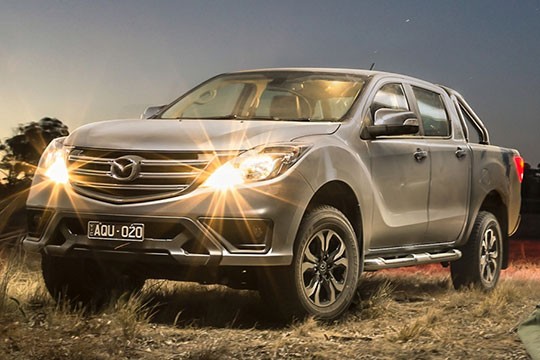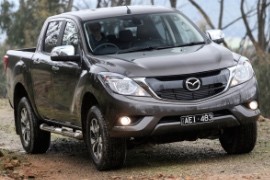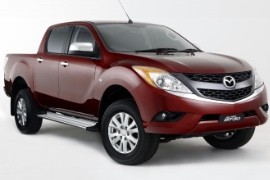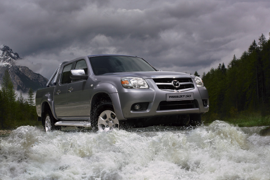MAZDA BT-50 Models/Series Timeline, Specifications & Photos
First production year: 2006
Engines: Diesel, Gasoline
Body style: Truck
Even if the Mazda and Ford took different paths after their divorce in 2008, both companies worked together for specific models, such as Mazda BT50 and Ford Ranger.
The first generation of the Mazda BT50 pick-up was unveiled in 2006, and it was the Japanese branded Ford Ranger pick-up. It featured a different styling, but it had its customers, especially on the Asian continent. The second generation was introduced in 2010 in Australia, and it continued the journey of its predecessor as a working pick-up until 2018, when it went through an important update.
From the styling point of view, the BT50 was nowhere close to the Ford Ranger, especially on the exterior look. The front side resembled the Mazda 6, and the flared wheel-arches and leaf-style headlights resembled the Mazda 3. But from the A-pillars to the back, the car shared most of its body panels with the Ford Ranger.
Inside, depending on the trim level, the BT50 offered a rugged or a family environment. The binocular-style instrument cluster, with an LCD between the dials, showed the car's essential information. On the base models, only a basic audio system and a manual air-conditioning unit were hosted on the center stack. The upper trim levels had an infotainment unit with Apple CarPlay and Android Auto compatibility.
Mazda offered the BT50 with the top-engine version available on the Ranger from that era, the 3.2-liter inline-five unit from the Ranger Wildtrak. It was paired to a standard 6-speed manual, and a 6-speed automatic was available on the options list. A low-range gear was fitted as standard on all 4x4 models.
Mazda and Ford used to build their pickups together for the European and Australian markets in Thailand, and the Japanese cousin of the Ranger was named BT-50.
Even after Ford and Mazda split, the two carmakers continued to work together on several projects, such as pickup manufacturing. After all, Ford was the most successful carmaker in the world in that area, while Mazda was still a newbie on the market. The 2015 BT-50 was the facelifted version of the 2011 model, which was made together with Ford. It shared only the windshield, the cabin's structure, and some parts of the bed for the bodywork and the chassis.
Mazda tried to apply on the BT-50 the same design language used for the rest of the range on the outside. It was difficult to say if it was a good idea to have a Mazda pickup with a Mazda3 front fascia, but it was a good idea in some ways. Thus, the vehicle seemed to be more of a lifestyle pickup than a hard-worker. Its swept-back headlights and the chromed grille were not supposed to face the harshness of a construction yard. It was meant to be driven on a ski resort. But the BT-50 was able to do both.
Inside, the carmaker used the binocular-style instrument cluster with the tachometer and speedometer in individual casings. Between them, Mazda installed a red-on-black LCD. The carmaker had to use whatever Ford had in mind for the infotainment system, but with a different front fascia.
Under the hood, the BT-50 was still a rugged off-road pickup. It featured a strong ladder chassis with independent front suspension and a live rear axle. It was paired as standard to a 6-speed manual transmission, while a six-speed automatic was on the options list.
MAZDA BT-50 2.2L 6AT 4x2 (150 HP) Single Cab
MAZDA BT-50 2.2L 6MT 4x2 (150 HP) Single Cab
MAZDA BT-50 3.2L 6AT 4x2 (200 HP) Dual Cab
MAZDA BT-50 3.2L 6AT 4x2 (200 HP) Freestyle Cab
MAZDA BT-50 3.2L 6AT 4x4 (200 HP) Dual Cab
MAZDA BT-50 3.2L 6AT 4x4 (200 HP) Freestyle Cab
MAZDA BT-50 3.2L 6AT 4x4 (200 HP) Single Cab
MAZDA BT-50 3.2L 6MT 4x2 (200 HP) Dual Cab
MAZDA BT-50 3.2L 6MT 4x2 (200 HP) Freestyle Cab
MAZDA BT-50 3.2L 6MT 4x2 (200 HP) Single Cab
MAZDA BT-50 3.2L 6MT 4x4 (200 HP) Dual Cab
The second generation of the BT50 was designed by Mazda's research center based at Ford Australia's design center. It shares fewer elements with the Ford Ranger and offered a true Mazda look.
Depending on the continents, a pickup might or not be important to the market. If you ask a European, that kind of vehicle is almost useless. But in the U.S. or Australia, the 4x4 light utility vehicle segment is more important. Mazda didn't want to lose a slice of the pie and continued its cooperation with Ford for the BT50, even though the two companies split in 2008.
From the outside, the front fenders and the headlights reminded of the Mazda 6 sedan. With its swept and angled headlights, it looked more like an SUV rather than a rugged pickup truck. Its flared arches and wave lines on its side, the BT50 was designed more for lifestyle than for work. But the chassis underneath and the leaf-springs in the back confirmed its utility backbone. It was offered as a 2-door chassis-cab, an extended cabin with rear suicide doors and two tiny seats in the back and a full-size 4-door, which was more suitable for an active lifestyle vehicle.
The interior was a punishment for the rear passengers in the cab-extended version, but good for the four-door one. The dashboard featured an unusual flowing center stack that connected to the center console, in car-like design inspiration. The two cylindrical dials and a TFT display between them completed the instrument cluster.
For the drivetrain, the 2011 BT50 was offered in two choices of engines: a 2.2-liter good for fleets and a powerful 3.2-liter. The standard transmission was a 6-speed manual, while a 6-speed auto was on the list. The BT50 was available with either rear or 4x4 on demand.
MAZDA BT-50 2.2L 5MT 4x2 (120 HP) Freestyle Cab
MAZDA BT-50 2.2L 5MT 4x2 (120 HP) Single Cab
MAZDA BT-50 2.2L 6MT 4x2 (120 HP) Double Cab
MAZDA BT-50 2.2L 6MT 4x2 (120 HP) Freestyle Cab
MAZDA BT-50 2.2L 6MT 4x2 (120 HP) Single Cab
MAZDA BT-50 3.2L 6AT 4x2 (200 HP) Double Cab
MAZDA BT-50 3.2L 6AT 4x2 (200 HP) Freestyle Cab
MAZDA BT-50 3.2L 6AT 4x4 (200 HP) Double Cab
MAZDA BT-50 3.2L 6MT 4x2 (200 HP) Double Cab
MAZDA BT-50 3.2L 6MT 4x2 (200 HP) Freestyle Cab
MAZDA BT-50 3.2L 6MT 4x2 (200 HP) Single Cab
MAZDA BT-50 3.2L 6MT 4x4 (200 HP) Double Cab
Ford Motor Company had a big chunk of Mazda in 2006 when the Japanese brand launched the BT-50 pickup, a vehicle that shared the same underpinnings with the European Ford Ranger.
Mazda was not at its first pickup model. The BT-50 replaced the former B-Series, known in Europe as B-2500. Ford considered that the Japanese brand was very appreciated on some markets and decided to do a badge-engineering product with the Ranger/BT-50 range.
The Japanese carmaker already had a good reputation in terms of reliability and ruggedness from the B-Series. When it designed the BT-50, it counted on that, but it noticed that pickups attracted some customers for recreational activities, not work. The front area resembled the Mazda Tribute SUV. Its headlights were slightly curved on their upper sides, and the body-colored plastic bumper didn't look like it belonged to a utility vehicle. The carmaker installed a chromed horizontal slat in the middle for the grille, flanked on the upper and lower side by two additional chromed trims.
Inside, it was more of an SUV than a workhorse pickup. The carmaker designed the dashboard in the new-edge design style, with a curved line that emerged from the center stack to the passenger's side. Mazda installed steering wheel buttons and a binocular-style instrument panel for the driver, with separate clusters for the speedometer and tachometer. In the back, the four-door version featured a flat bench for three, which was not the most desirable place to sit in a pickup.
Under the hood, Mazda offered the BT-50 with a choice of two engines carried over from Ford. Depending on the market, the carmaker provided the vehicle with either a 2.5-liter or a 3.0-liter unit, both paired to a five-speed manual as standard, with an option for an automatic transmission.



